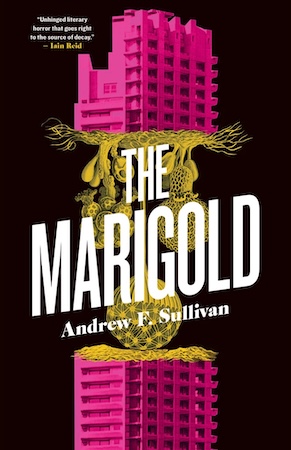 REVIEW:
REVIEW:
The Marigold by Andrew F. Sullivan
Runestone, volume 10

REVIEW:
The Marigold
by Andrew F. Sullivan
Runestone, volume 10
Reviewed by Lily Gibbs
—
“Before everything that happened, before the towers, before the site plans, before the deeds, before the failing sports bar and two-bedroom apartment above it that operated like another, more financially successful, unlicensed sports bar until the police shut it down after that one Polish kid got strangled with a pair of pink stockings behind the abandoned Shoppers Drug Mart a block or two south, there were trees here.”
Take a moment to envision the future of the city you live in – what will things look like ten or fifteen years from now? Do you picture skyscrapers, or rotted apartment buildings climbing 88 stories high? Are there trees and parks, or massive sinkholes swallowing people whole? Is the city clean, or is there a mysterious spore-emitting sludge slowly spreading all around? In The Marigold, Andrew F. Sullivan paints a captivating picture of Toronto in the not-so-distant future. Part horror, part sci-fi, and part social commentary, The Marigold offers a gritty, grimy perspective on growth, decay, and consequences.
The novel follows a captivating cast of characters, including health inspectors trying to contain the sentient sludge, developers who will stop at nothing to keep building and profiting, a 13-year-old girl looking for a lost friend, and of course, residents of The Marigold—the glimmering condo tower rotting from within. Through these characters, we get to see just how Toronto has been impacted by the spreading sludge, known as ‘The Wet,’ which releases toxic spores and drags people underground as it attempts to take over the city. While there are far too many characters to really get into, they each have their own goals and motivations—motivations that often toe the line between ‘good’ and ‘bad’ as Toronto eats itself. These characters, all unique and incredibly human, give the reader the ability to imagine themselves in all sectors of society in Sullivan’s imagined future for our world.
Although we’ve yet to get to the point where our cities are consuming us and vomiting up sentient toxic waste, it has gotten harder and harder to deny that we’re destroying our world. Above all, this is what Sullivan is trying to tell us through The Marigold. The novel is a commentary on the state of our environment first and foremost, and a powerful one at that. By focusing on themes of death, decay, and rot, Sullivan warns us that a future such as this isn’t out of the realm of possibility anymore, and someday we will all have to face nature’s consequences. What happens when we let the state of Capital go too far? What happens when we become too consumed by building, expanding, and improving? What happens when our desire for more—more real estate, more money, more power—becomes too much?
What makes The Marigold compelling is how realistic it is in the sense that this could be us someday. Sullivan does an incredible job of taking real-life consequences of climate change (flooding, changes in weather, a slow loss of natural life, etc.) and turns them into horrific things that will no doubt stick in your mind for a long time. The Marigold is a call to action, pushing us to do everything we can to avoid something similar happening in our world. While there may not be conscious, all-consuming mold in our cities (at least not yet), the damage done in the name of growth and progress can still be felt, and it’s high time we reflect on what humanity really stands for. Is growth really growth at all if the aftermath is decay and destruction?

Lily Gibbs
Hamline University
LILY GIBBS is a Creative Writing and Education major who hopes to someday publish her own horror novel. When she’s not writing, she spends her time making jewelry and playing with her cat, Venus.

